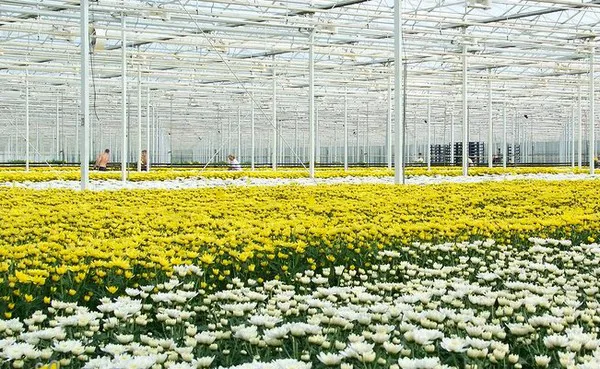Chrysanthemums are a light-loving crop that can be sensitive to too much heat. Advisor Paul de Veld explains the choice of coatings and the sector’s trends.
Paul de Veld is a Senior Consultant at Delphy and specializes in chrysanthemums. One of his customers grows the compact Santini variant, which has various varieties. ‘This company grows a variety that is sensitive to vegetative growth when there is too much radiation and too much heat. This slows down flower bud development and results in secondary growth: the side shoots near the flower start to grow. This effect especially occurs when temperatures are too high during bud development during short-day treatment,’ he says.
Because the crop needs a short day for bud development. During that period the black-out curtain is closed more than half the time every 24 hours. During the summer, the temperature below the curtain becomes quite high. A coating can then help keep the 24-hour temperature down, which results in a lower temperature during the day. In addition, the temperature below the curtain stays lower when the sun still shines on it.

De Veld: ‘We already discuss the strategy in the spring. We then list our expectations for the relevant variety and what our experience was in the previous year. Besides the problems with vegetative growth, the flower’s color in some varieties fades when it is hot. Then we assess which coating would be most effective in tackling the problems.’
The right choice
Basically, there are two possible coatings that can be used to bring the temperature down: ReduHeat and ReduFuse IR. ‘ReduFuse IR is preferred as it allows just a bit more light in. In addition, diffuse light is beneficial for the crop’s growth and development. ReduHeat would be the preferred choice only when proper color development is very sensitive to heat,’ he says.
The conclusion of the grower’s analysis was that ReduFuse IR was the right choice. ‘The grower has several years of experience now with this coating. You can see that the undesirable lush, vegetative growth has been eliminated and that the flower quality is better. Taking PAR light measurements is not common practice in chrysanthemum cultivation. This is why we are unable to quantify the effect. However, just looking at the crop, the positive effect of the coating is easy to see.’
When a coating is used, it is still possible for direct sunlight to fall on the plants through open windows. This can clearly damage a crop’s colouring. ‘Without a coating you would need to close the black-out curtain 85-90% at times like this. When a coating is used 60% is sufficient. This creates a better climate due to improved air circulation. In addition, due to the use of ReduFuse IR, the light differences below the black-out curtain are much less,’ he says.
Hot summers
In recent years De Veld has seen an increase in the use of ReduFuse IR among his customers. This is no doubt due to the consecutive hot summers. Of course it is impossible to predict what the summer weather is going to be like.
‘This is why some people are adopting a “wait-and-see” approach. This means that they have to respond quickly to the weather forecast when the time comes. In the event of an unfavourable weather forecast they have a professional contractor apply ReduSol, or sometimes SprayChalk, to the section of the greenhouse with the oldest crop,’ he says.
This way flower discolouring or burnt flower petals can be prevented. The most suitable coating depends on the variety. ‘ReduFuse would be highly suitable for varieties that experience difficulty with evaporation at high radiation levels after which causes the plant to wilt. This is often due to the limited amounts of stomata. These varieties have become far less popular in recent years, as a result of which chrysanthemum growers hardly choose ReduFuse anymore.’
For more information: ReduSystems
ReduSystems
+31(0)13 507 53 99
sales@redusystems.com
www.redusystems.com
